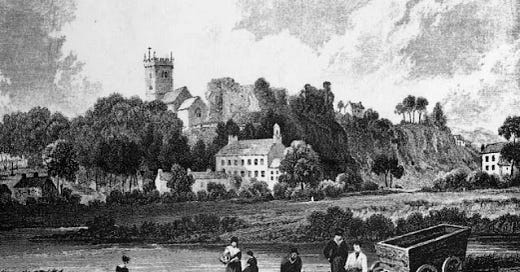I recently stumbled across a copy of 'The Universal British Directory, 1791'. The directory itself comprised five detailed volumes. It (mainly) focuses on the positive aspects of the towns, as it was written to be appealing to visitors and the reader.
For each place, there is a brief description of the town that includes some of its history, and industry and goes on to list gentry and traders.
Luckily for us, Bridgend is included in one of the volumes! Although the entry is brief, it does give us an insight into Bridgend in the late 18th century.
Below are extracts taken from the directory about the town of Bridgend and its traders.
"Situated on the River Ogmore, in the centre of the county and is 10 miles from Cardiff – 8 miles from Cowbridge and 181 miles from London. It has a good market weekly on Saturday; and two fairs annually – November 17th and Holy Thursday which are well supplied with cattle of every description."
"The mail coach from London to Milford Haven and from thence to London passes by this town about one o'clock every morning but the post road turns off at Ewenny Bridge about a mile south of the town, at which place the letter bags are left and parcels delivered."
"It is pretty populous, tolerably well-built and is daily improving. The inhabitants have most of their goods from Bristol and the conveyance for which is by the Newton boats once a fortnight, and for small parcels by the above coach daily or the Bristol newsman once a week."
"The town is divided into three parts and is distinguished by the names of Oldcastle, Bridgend and Newcastle; there are still remains of castles at the former and latter of those places; but the appellation of Bridgend serves for the whole as it is in that part that the markets are held and the greatest business transacted."
"The bridge over the River Ogmore divides Bridgend from Newcastle. The soil around this place is extremely fertile and cultivated, and as several English families have been induced to settle in this neighbourhood, the market is of late so much improved that the inhabitants are enlarging and making the marketplace quite commodious, and the provisions of every sort brought thereto are as good as any in England. Here is a neat town hall and the member for the county has been sometimes elected at this place."
"The agriculture society of this country is beginning to establish a woollen manufactory in this town, they have a spinning jenny, carding machine and all the necessary apparatus for that purpose and it is hoped, that in a little time, it will have the desired effect, as the water that runs through the town is allowed to be if as good a quality for the manufacture of woollen goods as any in the kingdom."
"At Oldcastle is a chapel of ease under Coity that being the mother church; and at Newcastle is a tolerable well-built parish church situated in such an eminence as to command a delightful land extensive prospect of the surrounding country."
"The River Ogmore abounds with salmon, sewn, trout and a variety of other fish, with which in the season the markets are well supplied. About half a mile north of the town is a quarry of excellent freestone, the property of Richard Price Esq, which is equal to any stone in England and is now used. The principal inns in this town are the Wyndham Arms and the Globe."
"Dunraven Castle is the seat of Thomas Wyndham, Esq member for the county of Glamorgan. The pleasant village of Southerndown which is close to Dunraven is an exceeding good sea bathing place."
As mentioned above, the entry mentions Bridgend traders. It is by no means a comprehensive list, but it does mention a few familiar names, public houses and interesting occupations.
Although thirteen Victuallers are listed, only ten are mentioned by name: White Lion, Six Bells, Red Lion, The Ship, Welcome to Town, The Lamb, Wyndham Arms Inn, The Angel, The Globe and The Greyhound.
Two Tollgate Keepers are listed: Catherine Flew and Morris Jones. They kept the gates at the bottom of Newcastle Hill and at the top of what is now Caroline Street.
Walter Coffin and his tannery are listed. Walter was a descendant of Rev Dr Richard Price and father of Walter Coffin the MP for Cardiff. He ran a very successful tannery on the site of what is now the Rhiw Carpark. He was also part owner of St John’s House on Newcastle Hill.
Other occupations listed include: Currier, Clothier, Glazier, Brazier, Malster and one Peruke Maker.







If the building recently demolished as The Welcome to Town Pub was the same building listed in 1791 it should have definitely listed as my understanding is that that nearly every pre 1840 building in a reasonable state and not heavily altered would/should have been listed by Cadw?
Great research, as ever. Amazing to see how our little town was viewed by visitors as it grew. It sounds like a happy little place.
Thank you